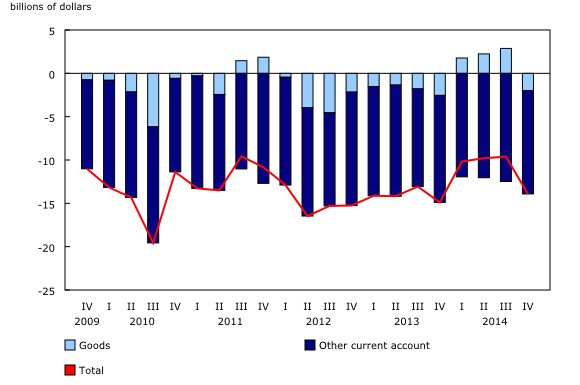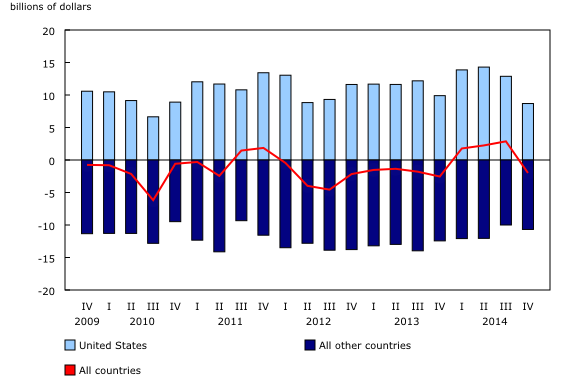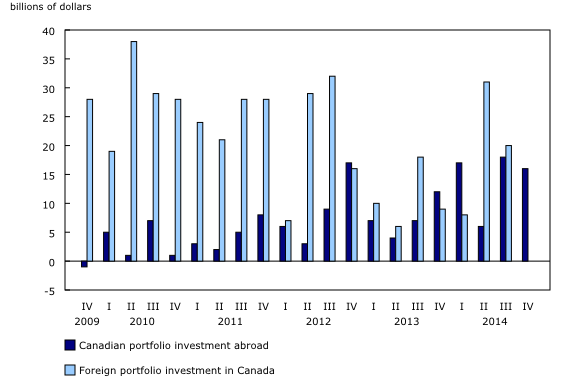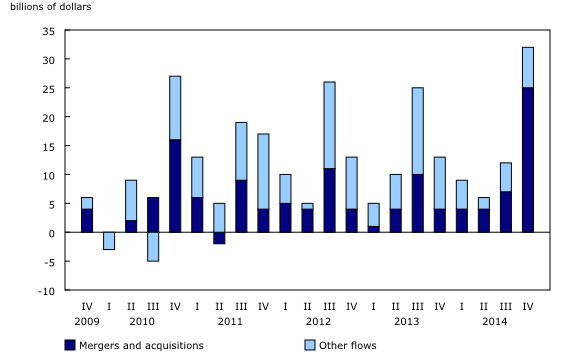Canada's balance of international payments, fourth quarter 2014
Archived Content
Information identified as archived is provided for reference, research or recordkeeping purposes. It is not subject to the Government of Canada Web Standards and has not been altered or updated since it was archived. Please "contact us" to request a format other than those available.
Released: 2015-03-02
Canada's current account deficit (on a seasonally adjusted basis) expanded by $4.3 billion in the fourth quarter to reach $13.9 billion. This change mainly reflected the deterioration of the trade in goods balance.
In the financial account (unadjusted for seasonal variation), increased foreign currency deposits held in Canada by non-residents was the largest contributor to the inflow of funds into the economy.
For the year 2014, the current account deficit narrowed by $12.8 billion to reach $43.5 billion, in line with a strengthened goods balance. In the financial account, most of the inflows of funds from abroad were the results of transactions in the other investment category. In contrast to recent years, foreign direct and portfolio investment contributed minimally to the net cross-border inflow of funds.
Current account
Trade in goods balance returns to a deficit
The balance on international trade in goods recorded a $2.0 billion deficit in the fourth quarter, following a $2.9 billion surplus in the previous quarter. This was the first deficit since the fourth quarter of 2013. Nevertheless, for 2014 as a whole, the balance on goods expanded by $12.1 billion to reach a surplus of $4.9 billion.
Overall, the total exports of goods declined by $3.4 billion to reach $131.8 billion in the fourth quarter, led by a reduction in energy products. Exports of energy products were down $4.2 billion, largely on lower prices for crude petroleum. Farm, fishing and intermediate food products were down $1.1 billion with lower volumes of canola and wheat. Metal and non-metallic mineral products were up $0.7 billion on higher volumes, mainly aluminum products and precious metals.
Total imports of goods were up $1.5 billion to $133.8 billion in the quarter. Consumer goods advanced $0.7 billion on higher prices. Motor vehicles and parts increased $0.6 billion on higher volumes of cars and a combination of stronger volumes and prices for parts. Metal and non-metallic mineral products rose $0.5 billion, led by higher volumes of precious metals. These gains were partially offset by a $1.0 billion reduction in imports of energy products, mostly from lower prices of crude petroleum.
On a geographical basis, the surplus with the United States was down by $4.2 billion to $8.7 billion in the fourth quarter, the lowest surplus since the third quarter of 2010. Exports to the United States were down $2.4 billion, led by weaker sales of crude petroleum. On the other side of the ledger, imports from the United States were up $1.7 billion. The overall deficit with non-US countries increased $0.7 billion on lower exports.
The goods deficit with China advanced $1.0 billion to reach $4.3 billion, the highest level since the fourth quarter of 2008. This reflected lower exports and higher imports. The deficit with South Korea also widened. Meanwhile, the surplus with United Kingdom was down by $0.7 billion, mainly on weaker exports. On the other hand, trade balances with Hong Kong, Iraq, Netherlands, and Switzerland all improved in the quarter. This had a moderating effect on the swing from a surplus to a deficit on trade in goods.
Lower deficits on trade in services and investment income
The deficit on international transactions in services narrowed by $0.1 billion in the fourth quarter to $5.5 billion. This was in line with the surplus on commercial services expanding by $0.1 billion, on stronger receipts. The travel and transportation deficits were largely unchanged.
The investment income deficit shrank by $0.4 billion to $5.7 billion. Profits earned in Canada by foreign direct investors were down by more than those earned abroad by Canadian direct investors. Earnings on both portfolio assets and liabilities continued to advance in the quarter.
Financial account
Foreign investment in Canadian securities reaches a six-year low
Foreign investors acquired $0.3 billion of Canadian securities in the fourth quarter, down from the $20.1 billion investment in the previous quarter. Non-residents continued to invest in Canadian debt securities, but at a slower pace in the quarter, while reducing their holdings of equities. As a result, foreign investment in Canadian securities in the fourth quarter was the lowest in six years.
Foreign holdings of Canadian debt securities were up $3.7 billion in the quarter. Non-resident investors added $5.4 billion of Canadian bonds to their portfolio, largely corporate bonds denominated in US dollars. At the same time, they withdrew $1.6 billion from the Canadian money market, mainly retirements of provincial paper.
International investors sold $3.5 billion of Canadian equities in the quarter, marking the first such divestment since the first quarter of 2013. Nonetheless, foreign investment in Canadian equities in 2014 was the highest in five years. Canadian stock prices were down 2.2% in the fourth quarter.
Canadian investment in foreign securities remains strong
Canadian investors acquired $16.0 billion of foreign securities in the quarter with most of the activity recorded in December. Canadian purchases of foreign debt securities were $9.6 billion, mainly US bonds.
Canadian acquisitions of foreign equities amounted to $6.4 billion, a sixth consecutive quarter of investment. On an annual basis, Canadian investment in foreign shares totalled $35.7 billion in 2014, the largest such outflow of funds since 2000.
Growth in foreign direct investment led by mergers and acquisitions
Canadian direct investment abroad reached $31.7 billion in the fourth quarter and was mainly placed in the United States. This was the largest such outflow since the first quarter of 2008. Record cross-border mergers and acquisitions in the quarter accounted for the bulk of the outward direct investment. Led by the activity in the fourth quarter, Canadian direct investment abroad in 2014 was the highest in six years.
Foreign direct investment in Canada amounted to $17.7 billion in the fourth quarter, the highest in nearly two years. Most of the activity resulted from cross-border mergers and acquisitions.
The other investment category generates large inflows of funds
Transactions in the other investment category of the financial account generated a large net inflow of funds in the fourth quarter. This activity mainly reflected an increase in foreign currency deposits held by non-residents in Canada.
Financing patterns in 2014
Most of the inflows of funds from abroad in 2014 were the results of transactions in the other investment category, largely from transactions in the banking sector. The contribution of direct and portfolio investment transactions were both reduced in the year.
International transactions in securities generated a net inflow of funds to the Canadian economy of $3.4 billion in 2014. This marked a seventh straight year of net inflows in this type of investment, but the lowest since 2008 during the global financial crisis.
Inward direct investment slightly exceeded outward direct investment by $1.4 billion in 2014, compared with $20.6 billion in 2013. This activity followed five straight years of net outflows of funds on direct investment.
Note to readers
The balance of international payments covers all economic transactions between Canadian residents and non-residents in three accounts: the current account, the capital account and the financial account.
The current account covers transactions in goods, services, compensation of employees, investment income and secondary income (current transfers).
The current account data in this release are seasonally adjusted. For more information on seasonal adjustment, see Seasonally adjusted data – Frequently asked questions.
The capital account covers capital transfers and transactions in non-produced non-financial assets.
The financial account covers transactions in financial assets and liabilities.
In principle, a net lending (+) / net borrowing (-) derived from the sum of the current and capital accounts corresponds to a net lending (+) / net borrowing (-) derived from the financial account. In practice, as data are compiled from multiple sources, this is rarely the case and gives rise to measurement error. The discrepancy (net errors and omissions) is the unobserved net inflow or outflow.
For more information about the balance of payments, consult the "Frequently asked questions" section in the System of macroeconomic accounts module of our website. The module also presents the most recent balance of payments statistics.
The balance of international payments data for the first quarter will be released on May 28.
Contact information
For more information, contact us (toll-free 1-800-263-1136; 514-283-8300; infostats@statcan.gc.ca).
To enquire about the concepts, methods or data quality of this release, contact Denis Caron (613-808-2278; denis.caron@statcan.gc.ca), International Accounts and Trade Division.
- Date modified:





